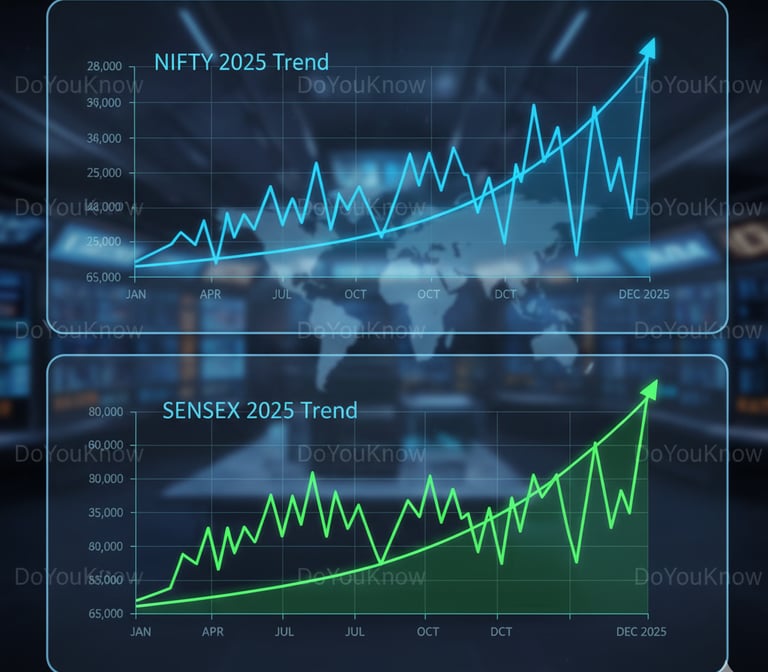Do You Know How India’s Stock Market Trends Are Shaping Investor Decisions
Discover how India’s stock market trends in 2025 influence investor decisions, behavior, and strategies for smarter investing.
BUSINESS & ECONOMY
Do You Know Team
9/27/20256 min read


India’s stock market has emerged as one of the most dynamic financial ecosystems in the world, reflecting not only the health of the economy but also the collective sentiment of millions of investors. In 2025, this market is at a pivotal juncture, balancing domestic growth prospects with global economic uncertainties. Benchmark indices like the Nifty 50 and Sensex are closely monitored by investors, analysts, and policymakers alike, serving as a barometer for the nation’s economic trajectory.
Investors today are no longer passive spectators. Retail participation has surged, aided by technology, social media, and easy access to trading platforms. Institutional investors have become more sophisticated, using data analytics and algorithmic models to make precise decisions. In this environment, understanding how stock market trends influence decisions is critical for anyone seeking to navigate the complexities of investing in India.
This article dives deep into the historical evolution of the Indian stock market, analyzes current trends, explores investor psychology, evaluates global and domestic influences, and offers actionable insights into how investors can make informed decisions.
The Historical Journey of India’s Stock Market
India’s financial markets have a rich history dating back to 1875, with the establishment of the Bombay Stock Exchange (BSE). Initially, trading was limited to a handful of brokers and businessmen, with minimal regulations. Over time, reforms and modernization expanded market participation, enhanced transparency, and introduced technology into trading. The 1990s marked a turning point with electronic trading and the rise of the National Stock Exchange (NSE), which offered advanced trading systems, faster settlements, and robust regulatory oversight.
Indices such as Sensex and Nifty 50 emerged as key benchmarks, reflecting both corporate performance and overall economic health. These historical shifts laid the foundation for a market where retail investors, institutional players, and foreign investors coexist, creating a diverse and dynamic investment ecosystem.
Past market events—such as the dot-com bubble, the 2008 global financial crisis, and domestic corrections—have left lasting lessons. Investors learned the importance of diversification, the impact of global factors on domestic markets, and the psychological influences that drive decision-making. These lessons continue to shape investor behavior in 2025.
Market Trends and Performance in 2025
The Indian stock market in 2025 has experienced periods of volatility interspersed with growth. The Nifty 50 and Sensex indices have oscillated due to factors like corporate earnings reports, policy announcements, global trade fluctuations, and foreign investment flows. While technology and consumer sectors have shown resilience, traditional industries such as manufacturing and energy have faced challenges from global supply chain disruptions.
Investors now segment their strategies according to risk appetite and investment horizon. Long-term investors focus on fundamentally strong companies and diversified portfolios, while short-term traders often respond to market momentum and news-driven trends. This mix of strategies influences trading volumes, sector rotation, and price movements, reflecting the diverse decision-making approaches in the market.
Sector-specific trends have a profound impact on investor behavior. For instance, IT companies exporting software services to global clients are experiencing steady demand, attracting investor attention despite global slowdown fears. The financial services sector, after initial turbulence from regulatory changes, has become a preferred investment destination for conservative investors. Retail investors often follow these trends, demonstrating the link between perceived opportunity and actual investment behavior.
Economic Indicators and Their Influence on Decisions
Economic indicators such as GDP growth, inflation, interest rates, and employment figures are crucial in shaping investor decisions. Positive GDP growth boosts confidence, encouraging investments in equities. Conversely, rising inflation or unfavorable employment data may prompt risk-averse behavior, pushing investors toward safer instruments.
Monetary policies by the Reserve Bank of India (RBI) also play a pivotal role. Rate cuts can enhance liquidity and stimulate investment, while rate hikes may slow borrowing and temper speculative activity. Investors constantly monitor these indicators, adjusting their portfolios to align with macroeconomic realities. Behavioral responses to these indicators—such as panic selling during negative news or aggressive buying in bullish scenarios—further amplify market trends.
Global Influences and Their Ripple Effects
India’s stock market is increasingly linked to global developments. Fluctuations in oil prices, currency exchange rates, international trade agreements, and geopolitical tensions significantly influence domestic equities. Foreign institutional investors (FIIs) respond to these cues, and their inflows or outflows can create substantial market movements.
For example, in mid-2025, FII outflows caused temporary dips in major indices, reflecting concerns about global economic conditions. Savvy domestic investors leveraged these dips to acquire fundamentally strong stocks at attractive valuations, highlighting the opportunities created by global-market interconnections.
Investor Behavior and Psychological Factors
Investor psychology is a cornerstone of market dynamics. Behavioral finance has shown that decisions are often driven more by emotions than by rational analysis. Common biases include herd mentality, overconfidence, loss aversion, and anchoring. These factors can cause price bubbles, panic selling, and other market inefficiencies.
Retail investors in India are heavily influenced by social media, financial news, and peer discussions. Viral stories about stock performance, wealth creation, or sudden market surges can drive speculative activity. In contrast, institutional investors tend to rely on data-driven analysis, but they too are affected by macroeconomic and geopolitical trends.
Understanding these psychological influences is critical for crafting investment strategies that mitigate emotional reactions and align with long-term goals.
Technology and Market Accessibility
Technology has democratized investing. Mobile apps, online brokerages, and AI-driven analytics enable real-time data access, research, and trade execution. Algorithmic trading, though primarily institutional, indirectly influences retail markets by shaping liquidity and price discovery.
While technology empowers investors, it also brings challenges. Cybersecurity threats, misinformation, and overreliance on automated tools can impact decision-making. Investors must combine technological tools with analytical skills and judgment to make sound investment choices.
Regulatory Environment and Policy Impact
SEBI ensures market integrity, promoting transparency, investor protection, and fair practices. Policies on corporate governance, trading regulations, and disclosure requirements have a direct impact on investor confidence. Taxation, including capital gains and dividend taxes, shapes portfolio allocation, emphasizing after-tax returns. Government initiatives promoting financial literacy and long-term investing have also increased participation and awareness among retail investors.
Risk Management and Strategies for Investors
Effective risk management is essential. Diversification across sectors, asset classes, and geographies reduces vulnerability to market fluctuations. Investors balance long-term growth goals with short-term opportunities through systematic investment plans (SIPs), mutual funds, and carefully monitored portfolios. Robo-advisors and AI-based tools assist in portfolio rebalancing, risk assessment, and maintaining investment discipline.
Case Studies of Market Behavior
GRM Overseas Surge (2025): The edible oils company experienced growth due to increased demand and strategic expansions, demonstrating how sector performance and corporate strategy shape investor behavior.
FII Outflows Mid-2025: Global economic concerns prompted foreign investors to withdraw funds temporarily, creating volatility. Domestic investors who maintained long-term perspectives capitalized on this trend.
Retail Investor Trends: During corrections, retail investors often exhibit herd behavior, but disciplined long-term strategies yielded favorable outcomes for those avoiding impulsive decisions.
Future Outlook
India’s stock market is expected to grow long-term, supported by emerging sectors like renewable energy, electric vehicles, fintech, and healthcare. Demographic changes, technological adoption, and policy reforms will continue to influence trends. Short-term volatility is inevitable, but informed and disciplined investors are likely to achieve significant returns.
FAQ
Q1: What factors influence India’s stock market in 2025?
A: Domestic economic indicators (GDP, inflation, interest rates), global events, foreign investments, corporate earnings, investor sentiment, and technology adoption.
Q2: How do market trends affect investor behavior?
A: Trends influence confidence, risk appetite, and strategies. Bullish markets encourage risk-taking; bearish trends increase caution. Behavioral biases also play a role.
Q3: What global events impact the Indian market?
A: Oil prices, currency fluctuations, trade agreements, geopolitical tensions, and FII activity significantly affect market trends.
Q4: Why is behavioral finance important?
A: It explains why investors may act emotionally rather than rationally, helping design strategies to mitigate impulsive decisions.
Q5: How has technology changed investing?
A: Online platforms, mobile apps, and AI analytics allow real-time trading, research, and portfolio management, increasing accessibility but requiring vigilance.
Q6: Which sectors are trending in 2025?
A: IT, financial services, renewable energy, electric vehicles, and consumer goods are currently attracting investor attention.
Q7: How do regulatory policies influence decisions?
A: SEBI regulations, corporate governance rules, and taxation policies affect portfolio planning, confidence, and participation.
Q8: What strategies help in volatile markets?
A: Diversification, long-term investing, SIPs, and disciplined approaches reduce risk and improve returns.
Q9: How can retail investors benefit from trends?
A: By analyzing sectors, monitoring indicators, leveraging technology, and avoiding impulsive decisions, retail investors can capitalize on opportunities.
Q10: What is the future outlook?
A: Long-term growth is expected, driven by emerging sectors, policy reforms, and technology adoption. Short-term volatility will persist.
Conclusion
India’s stock market trends are not just numbers—they reflect economic realities, corporate performance, and human behavior. Investor decisions in 2025 are shaped by market performance, global developments, behavioral biases, and technological access. By understanding these factors, investors can make informed choices, mitigate risks, and achieve long-term financial goals.
#IndianStockMarket #InvestingIndia #Nifty50 #Sensex #InvestorBehavior #FinancialMarkets #StockTrends2025 #PortfolioManagement #EconomicIndicators #MarketAnalysis #DoYouKnow
Knowledge
Empowering minds with reliable educational content daily.
Newsletter Signup
© 2025 DoYouKnow. All rights reserved.
Stay Ahead of the Trends – Join Our Newsletter
